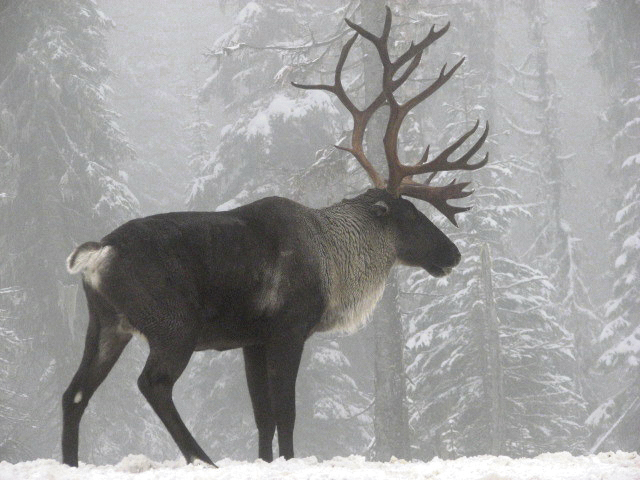Two not-for-profits dedicated to conservation and sustainable land management say the recently-released draft SK2 West caribou range plan is a positive step forward for the province.
The draft was sent out Tuesday and will go through a 60-day public consultation process. It’s the second of four range plans to be completed by the province as part of federally-mandated efforts to preserve woodland caribou, which are designated as a threatened species. The first three plans, SK2 west, central and east, look at the boreal plain ecosystem, which begins north of Prince Albert and continues to the northern boreal forest. That northern boreal forest is the fourth region that will receive a range plan.
Canadian Parks and Wilderness Society (CPAWS) Saskatchewan executive director Gord Vaadeland said the new range plan draft resembles the first completed plan, putting the province ahead of where it was when it released its first draft two years ago.
“I think there has been more emphasis on actual protection of caribou habitat versus just managing critical habitat,” he said.
The draft plan included several initiatives aimed at reducing the number of human-caused “disturbances” on the landscape. That includes things like highways, roads and seismic lines, mine sites, mills, and other things that interrupt the landscape. Because Saskatchewan doesn’t have reliable scientific data about the woodland caribou population, the federal government instead looks at the amount of disturbance in a region to predict whether the herd is healthy. The SK2 West region, for which the most recent range plan was released, has the highest percentage of both human-caused disturbance and wildfire.
“I’m glad… that they are still looking at reducing disturbance because there’s already a high rate of fire in there and signs suggest there’s potential for fire occurrence to increase as climate change continues to gain a foothold,” Vaadeland said.
“It’s definitely important to be looking at minimizing disturbance.”
Still, Vaadeland said, more needs to be done to ensure caribou habitat is being protected, and not just managed.
“We will be submitting some comments and some suggestions for improvement,” he said.
“It will be around strengthening language around protecting caribou habitat and reducing disturbance levels.”
The idea of protecting areas of the forest also earned support from the Prince Albert Model Forest (PAMF) and its manager, Sarah Schmid. The PAMF focuses on building communities “founded on healthy and sustainable forest management.”
“The Ministry of Environment is really coming around on ideas of protected areas as a management strategy,” Schmid said.
“It is moving in a better direction. We’re still behind on these range plans, especially the population analysis. But there was a good point that yes, we know the populations are declining. Let’s protect and manage the habitat first. We know based on Indigenous knowledge that the population shave been declining for some time.”
That element of the picture, Indigenous knowledge, was missing from the first range plan the province drafted. This time, they included an entire section dedicated to traditional knowledge and its importance in both tracking herd population and in promoting land conservation.
The report specifically mentioned work being done by PAMF and the Prince Albert Grand Council to understand caribou populations and promote conservation. PAMF receives funding from Environment and Climate Change Canada to work with communities and the province.
“I’ve seen a lot of good development in terms of engagement with communities, specifically First Nations communities,” Schmid said.
“It’s a big improvement from the first plan that came out to this plan because traditional knowledge was not mentioned as much in the first plan. This plan, they’re really trying hard to incorporate that into the document itself. There’s still a long way to go in terms of community engagement when it comes to the actual range planning process.”
That work engaging with Indigenous communities lines up with work CPAWS-Saskatchewan is doing with some forestry companies in the area, Vaadeland said.
Some forestry companies — he mentioned Mistik Management Ltd. And Alberta-Pacific Forest Industries (Alpac) by name — “are really pushing the envelope even further at protecting caribou habitat and looking where there are gaps in protected areas. This fits in really nicely.”
Mistik, Vaadeland said, has also been trying to engage with Indigenous communities in the region.
“It’s very compatible with the direction we have been going with the forest companies so that’s always helpful for sure when we’re generally pulling in the same directions and our disagreements are more minor in nature.”
While that engagement aspect is coming along, Schmid says more work needs to be done to ensure communities know what’s going on and what the future steps are.
“The main issue now is how do we communicate these plans to these communities. It’s 100-plus page documents that are very, very technical,” she said. “We’re working on how we are effectively going to communicate these management strategies and how we implement them.”
Why care about the caribou?
A question that comes up a lot Schmid said, is why people should care about protecting caribou habitat.
“That’s a question that always comes up. There are some communities that have never really relied on caribou. It has not been part of their culture,” she said.
Protecting caribou habitat helps protect other species as well, as woodland caribou thrive in healthy, older-growth boreal forests.
“When you’re protecting areas of the boreal forest, there is going to be an obvious, definite spinoff to other species,” Vaadeland said.
‘That’s why we’ve always looked at caribou as a multi-species opportunity. BY focusing on caribou habitat by default we will be catching a lot of other important species.”
That includes several bird species, he says.
“Woodland caribou are not migratory,” Schmid said.
“They’re free-wandering. They have their areas. Helping to protect their habitat, manage their habitat, protects other species as well. They are an old-growth forest species.
“If they’re not around, they’re telling us something may be wrong with our forests.”


